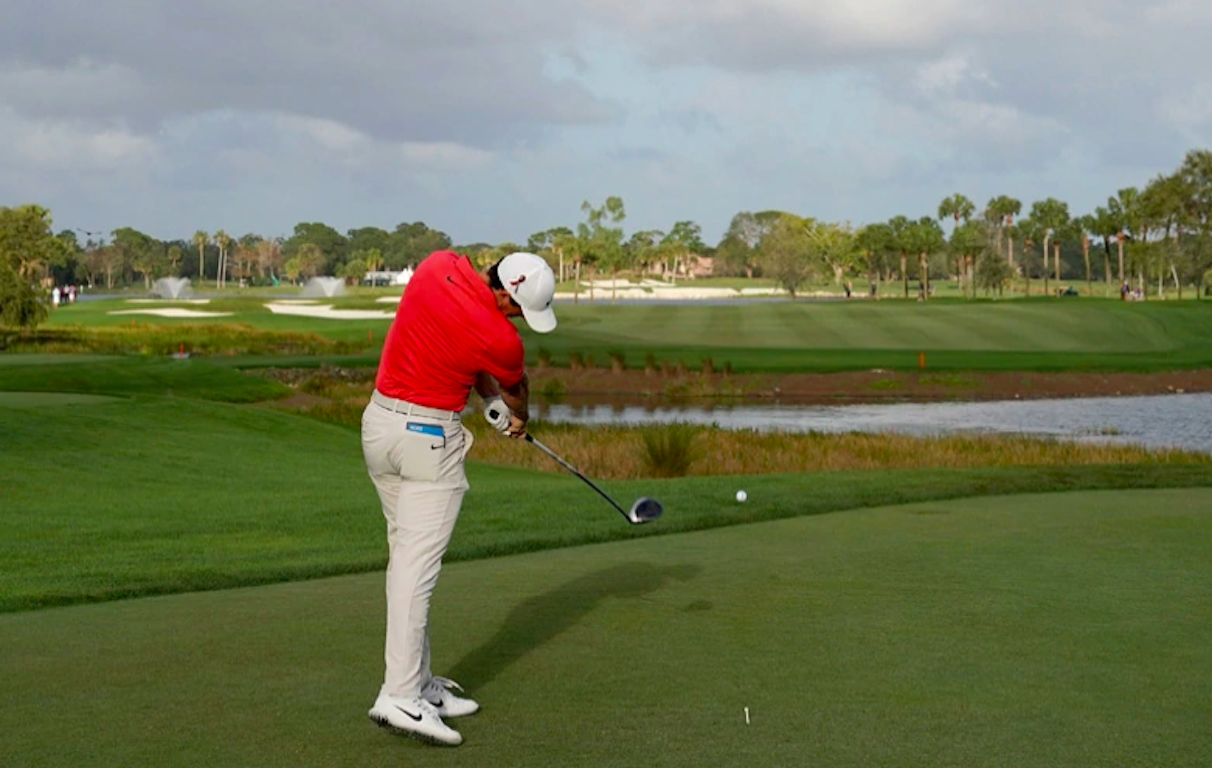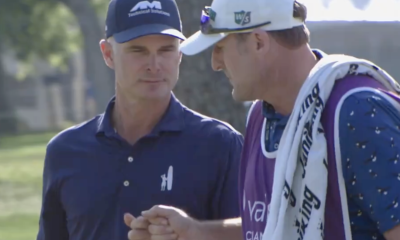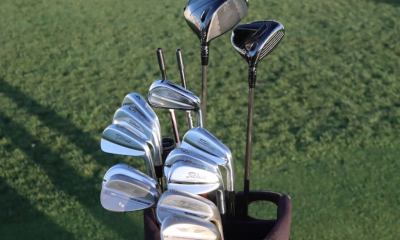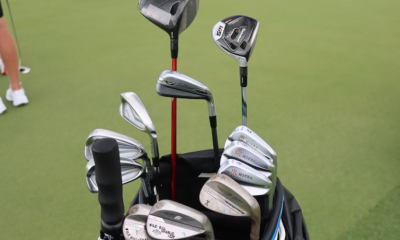Opinion & Analysis
The Wedge Guy: An examination of proper “release”

One of my favorite ‘contributions’ to this game I love is helping golfers t an “ah-ha” moment, wherein they gain an understanding of the idiosyncrasies of the golf swing that helps them make progress in their ball striking. In so many cases with recreational golfers, keys to improvement can be much more conceptual than physical. In other words, helping a golfer discover what really should be happening in various parts of the golf swing leads them to make their own swing alterations to adopt this new understanding.
I firmly believe that teaching through understanding is much more productive than trying to teach “a new move” through the physical approach. From my observation of recreational golfers, particularly those with “homemade” swings (which all have the potential to produce better and more consistent results in my opinion), one of the most misunderstood intricacies of the golf swing is how the club should be “released” through the impact zone.
Almost universally, golfers seem to think that the club releases through impact by or with an unhinging of the wrists, so that the left arm and shaft form a straight line.
If you genuinely want to improve your ball striking, your distance, your consistency and your scores, I suggest you pursue a genuine and technical understanding of this critical segment of the golf swing. Because most of you are
stuck in front of your TV right now–watching more golf than you are playing–you can make this time count. Every chance you get, watch the slow-motion videos of the golf swing from behind the golfer, looking down the line. A
straight-on view of the golf swing does not reveal this angle, but that is mostly what we are given in swing analysis by television and magazines, unfortunately.
[I’ll offer too, that you can learn a lot more from watching the LPGA players than the guys, as these very talented ladies are much closer to our own strength profiles. In my opinion, most of them are much more fundamentally
sound in their mechanics as they simply have to get the most efficiency out of the swing.]
What you will see, particularly with the wedge and short iron shots is that the hands and arms follow a path through impact that very nearly “covers” their position at address, where a distinct angle is formed by the left arm and shaft of the club…again, looking from behind the golfer down the target line.
As you study these videos and still photos, you’ll see that in the longer, more powerful swings–driver, metals, hybrids–the hands drift a little higher and away from the body more than they do with the middle and short irons, but the angle is still there. As you watch these guys hit the delicate short shots around the greens, the hands almost identically cover their address position.
That’s because a proper “release” of the club is not as much an unhinging of the wrists, but rather a rotation of the hands and arms through impact, in concert with and driven by the rotation of the body core itself. Close examination shows that the hands remain almost directly in front of the sternum through the entire impact zone, and the forearms and hands rotate – not unhinge – so that the club is squared at the ball for consistent impact.
Now, all this diagnosis would not be worth a dime to you if I didn’t show you how to experience this for yourself. Like most new physical activities, you are always best served by trying to LEARN IT IN SLOW MOTION! Simply pick up your 8- or 9-iron and find a place in your house or garage where you won’t take out a table lamp, and make very S-L-O-W swings, while concentrating on making this rotational release motion.
Your goal is to set up at address with the left arm hanging naturally from your shoulder, not pushed out toward the ball. Take the club back with a rotation of the body core, and then back through the impact zone, concentrating on making the left arm and hands exactly “cover” their address position. The angle of the wrists is maintained, and the club rotates through the ball, as your body rotates through impact.
Once you get the feel of it in slow motion, make slightly faster swings, concentrating on the path of the arms and that rotational release. When you actually hit balls with this newly-learned release–DO IT AT 35-50% POWER–you’ll be amazed at the boring trajectories and effortless distance you will get!
Let’s get some feedback on this, guys. How did you do?
- LIKE82
- LEGIT16
- WOW4
- LOL2
- IDHT1
- FLOP2
- OB1
- SHANK26
Instruction
The Wedge Guy: The easiest-to-learn golf basic

My golf learning began with this simple fact – if you don’t have a fundamentally sound hold on the golf club, it is practically impossible for your body to execute a fundamentally sound golf swing. I’m still a big believer that the golf swing is much easier to execute if you begin with the proper hold on the club.
As you might imagine, I come into contact with hundreds of golfers of all skill levels. And it is very rare to see a good player with a bad hold on the golf club. There are some exceptions, for sure, but they are very few and very far between, and they typically have beat so many balls with their poor grip that they’ve found a way to work around it.
The reality of biophysics is that the body moves only in certain ways – and the particulars of the way you hold the golf club can totally prevent a sound swing motion that allows the club to release properly through the impact zone. The wonderful thing is that anyone can learn how to put a fundamentally sound hold on the golf club, and you can practice it anywhere your hands are not otherwise engaged, like watching TV or just sitting and relaxing.
Whether you prefer an overlap, interlock or full-finger (not baseball!) grip on the club, the same fundamentals apply. Here are the major grip faults I see most often, in the order of the frequency:
Mis-aligned hands
By this I mean that the palms of the two hands are not parallel to each other. Too many golfers have a weak left hand and strong right, or vice versa. The easiest way to learn how to hold the club with your palms aligned properly is to grip a plain wooden ruler or yardstick. It forces the hands to align properly and shows you how that feels. If you grip and re-grip a yardstick several times, then grip a club, you’ll see that the learning curve is almost immediate.
The position of the grip in the upper/left hand
I also observe many golfers who have the butt of the grip too far into the heel pad of the upper hand (the left hand for right-handed players). It’s amazing how much easier it is to release the club through the ball if even 1/4-1/2″ of the butt is beyond the left heel pad. Try this yourself to see what I mean. Swing the club freely with just your left hand and notice the difference in its release from when you hold it at the end of the grip, versus gripping down even a half inch.
To help you really understand how this works, go to the range and hit shots with your five-iron gripped down a full inch to make the club the same length as your seven-iron. You will probably see an amazing shot shape difference, and likely not see as much distance loss as you would expect.
Too much lower (right) hand on the club
It seems like almost all golfers of 8-10 handicap or higher have the club too far into the palm of the lower hand, because that feels “good” if you are trying to control the path of the clubhead to the ball. But the golf swing is not an effort to hit at the ball – it is a swing of the club. The proper hold on the club has the grip underneath the pad at the base of the fingers. This will likely feel “weak” to you — like you cannot control the club like that. EXACTLY. You should not be trying to control the club with your lower/master hand.
Gripping too tightly
Nearly all golfers hold the club too tightly, which tenses up the forearms and prevents a proper release of the club through impact. In order for the club to move back and through properly, you must feel that the club is controlled by the last three fingers of the upper hand, and the middle two fingers of the lower hand. If you engage your thumbs and forefingers in “holding” the club, the result will almost always be a grip that is too tight. Try this for yourself. Hold the club in your upper hand only, and squeeze firmly with just the last three fingers, with the forefinger and thumb off the club entirely. You have good control, but your forearms are not tense. Then begin to squeeze down with your thumb and forefinger and observe the tensing of the entire forearm. This is the way we are made, so the key to preventing tenseness in the arms is to hold the club very lightly with the “pinchers” — the thumbs and forefingers.
So, those are what I believe are the four fundamentals of a good grip. Anyone can learn them in their home or office very quickly. There is no easier way to improve your ball striking consistency and add distance than giving more attention to the way you hold the golf club.
More from the Wedge Guy
- The Wedge Guy: Golf mastery begins with your wedge game
- The Wedge Guy: Why golf is 20 times harder than brain surgery
- The Wedge Guy: Musings on the golf ball rollback
- LIKE75
- LEGIT11
- WOW4
- LOL1
- IDHT0
- FLOP4
- OB1
- SHANK8
19th Hole
Vincenzi’s 2024 Texas Children’s Houston Open betting preview

As the Florida swing comes to an end, the PGA Tour makes its way to Houston to play the Texas Children’s Houston Open at Memorial Park Golf Course.
This will be the fourth year that Memorial Park Golf Course will serve as the tournament host. The event did not take place in 2023, but the course hosted the event in 2020, 2021 and 2022.
Memorial Park is a par-70 layout measuring 7,432 yards and features Bermudagrass greens. Historically, the main defense for the course has been thick rough along the fairways and tightly mown runoff areas around the greens. Memorial Park has a unique setup that features three Par 5’s and five Par 3’s.
The field will consist of 132 players, with the top 65 and ties making the cut. There are some big names making the trip to Houston, including Scottie Scheffler, Wyndham Clark, Tony Finau, Will Zalatoris and Sahith Theegala.
Past Winners at Memorial Park
- 2022: Tony Finau (-16)
- 2021: Jason Kokrak (-10)
- 2020: Carlos Ortiz (-13)
In this article and going forward, I’ll be using the Rabbit Hole by Betsperts Golf data engine to develop my custom model. If you want to build your own model or check out all of the detailed stats, you can sign up using promo code: MATTVIN for 25% off any subscription package (yearly is best value).
Key Stats For Memorial Park
Let’s take a look at several metrics for Memorial Park to determine which golfers boast top marks in each category over their last 24 rounds:
Strokes Gained: Approach
Memorial Park is a pretty tough golf course. Golfers are penalized for missing greens and face some difficult up and downs to save par. Approach will be key.
Total Strokes Gained: Approach per round in past 24 rounds:
- Tom Hoge (+1.30)
- Scottie Scheffler (+1.26)
- Keith Mitchell (+0.97)
- Tony Finau (+0.92)
- Jake Knapp (+0.84)
Strokes Gained: Off the Tee
Memorial Park is a long golf course with rough that can be penal. Therefore, a combination of distance and accuracy is the best metric.
Total Strokes Gained: Off the Tee per round in past 24 rounds:
- Scottie Scheffler (+0.94)
- Kevin Dougherty (+0.93)
- Cameron Champ (+0.86)
- Rafael Campos (+0.84)
- Si Woo Kim (+0.70)
Strokes Gained Putting: Bermudagrass + Fast
The Bermudagrass greens played fairly fast the past few years in Houston. Jason Kokrak gained 8.7 strokes putting on his way to victory in 2021 and Tony Finau gained in 7.8 in 2022.
Total Strokes Gained Putting (Bermudagrass) per round past 24 rounds (min. 8 rounds):
- Adam Svensson (+1.27)
- Harry Hall (+1.01)
- Martin Trainer (+0.94)
- Taylor Montgomery (+0.88)
- S.H. Kim (+0.86)
Strokes Gained: Around the Green
With firm and undulating putting surfaces, holding the green on approach shots may prove to be a challenge. Memorial Park has many tightly mowed runoff areas, so golfers will have challenging up-and-down’s around the greens. Carlos Ortiz gained 5.7 strokes around the green on the way to victory in 2020.
Total Strokes Gained: Around the Green per round in past 24 rounds:
- Mackenzie Hughes (+0.76)
- S.H. Kim (+0.68)
- Scottie Scheffler (+0.64)
- Jorge Campillo (+0.62)
- Jason Day (+0.60)
Strokes Gained: Long and Difficult
Memorial Park is a long and difficult golf course. This statistic will incorporate players who’ve had success on these types of tracks in the past.
Total Strokes Gained: Long and Difficult in past 24 rounds:
- Scottie Scheffler (+2.45)
- Ben Griffin (+1.75)
- Will Zalatoris (+1.73)
- Ben Taylor (+1.53)
- Tony Finau (+1.42)
Course History
Here are the players who have performed the most consistently at Memorial Park.
Strokes Gained Total at Memorial Park past 12 rounds:
- Tyson Alexander (+3.65)
- Ben Taylor (+3.40)
- Tony Finau (+2.37)
- Joel Dahmen (+2.25)
- Patton Kizzire (+2.16)
Statistical Model
Below, I’ve reported overall model rankings using a combination of the five key statistical categories previously discussed.
These rankings are comprised of SG: App (24%) SG: OTT (24%); SG: Putting Bermudagrass/Fast (13%); SG: Long and Difficult (13%); SG: ARG (13%) and Course History (13%)
- Scottie Scheffler
- Wyndham Clark
- Tony Finau
- Joel Dahmen
- Stephan Jaeger
- Aaron Rai
- Sahith Theegala
- Keith Mitchell
- Jhonnatan Vegas
- Jason Day
- Kurt Kitayama
- Alex Noren
- Will Zalatoris
- Si Woo Kim
- Adam Long
2024 Texas Children’s Houston Open Picks
Will Zalatoris +2000 (Caesars)
Scottie Scheffler will undoubtedly be difficult to beat this week, so I’m starting my card with someone who I believe has the talent to beat him if he doesn’t have his best stuff.
Will Zalatoris missed the cut at the PLAYERS, but still managed to gain strokes on approach while doing so. In an unpredictable event with extreme variance, I don’t believe it would be wise to discount Zalatoris based on that performance. Prior to The PLAYERS, the 27-year-old finished T13, T2 and T4 in his previous three starts.
Zalatoris plays his best golf on long and difficult golf courses. In his past 24 rounds, he ranks 3rd in the category, but the eye test also tells a similar story. He’s contended at major championships and elevated events in the best of fields with tough scoring conditions. The Texas resident should be a perfect fit at Memorial Park Golf Club.
Alex Noren +4500 (FanDuel)
Alex Noren has been quietly playing some of his best golf of the last half decade this season. The 41-year-old is coming off back-to-back top-20 finishes in Florida including a T9 at The PLAYERS in his most recent start.
In his past 24 rounds, Noren ranks 21st in the field in Strokes Gained: Off the Tee, 30th in Strokes Gained: Around the Green, 25th in Strokes Gained: Total on long and difficult courses and 21st in Strokes Gained: Putting on fast Bermudagrass greens.
In addition to his strong recent play, the Swede also has played well at Memorial Park. In 2022, Noren finished T4 at the event, gaining 2.2 strokes off the tee and 7.0 strokes on approach for the week. In his two starts at the course, he’s gained an average of .6 strokes per round on the field, indicating he is comfortable on these greens.
Noren has been due for a win for what feels like an eternity, but Memorial Park may be the course that suits him well enough for him to finally get his elusive first PGA Tour victory.
Mackenzie Hughes +8000 (FanDuel)
Mackenzie Hughes found himself deep into contention at last week’s Valspar Championship before faltering late and finishing in a tie for 3rd place. While he would have loved to win the event, it’s hard to see the performance as anything other than an overwhelming positive sign for the Canadian.
Hughes has played great golf at Memorial Park in the past. He finished T7 in 2020, T29 in 2021 and T16 in 2022. The course fit seems to be quite strong for Hughes. He’s added distance off the tee in the past year or and ranks 8th in the field for apex height, which will be a key factor when hitting into Memorial Park’s elevated greens with steep run-off areas.
In his past 24 rounds, Hughes is the best player in the field in Strokes Gained: Around the Greens. The ability to scramble at this course will be extremely important. I believe Hughes can build off of his strong finish last week and contend once again to cement himself as a President’s Cup consideration.
Akshay Bhatia +8000 (FanDuel)
Akshay Bhatia played well last week at the Valspar and seemed to be in total control of his golf ball. He finished in a tie for 17th and shot an impressive -3 on a difficult Sunday. After struggling Thursday, Akshay shot 68-70-68 in his next three rounds.
Thus far, Bhatia has played better at easier courses, but his success at Copperhead may be due to his game maturing. The 22-year-old has enormous potential and the raw talent to be one of the best players in the world when he figures it all out.
Bhatia is a high upside play with superstar qualities and may just take the leap forward to the next stage of his career in the coming months.
Cameron Champ +12000 (FanDuel)
Cameron Champ is a player I often target in the outright betting market due to his “boom-or-bust” nature. It’s hard to think of a player in recent history with three PGA Tour wins who’s been as inconsistent as Champ has over the course of his career.
Despite the erratic play, Cam Champ simply knows how to win. He’s won in 2018, 2019 and 2021, so I feel he’s due for a win at some point this season. The former Texas A&M product should be comfortable in Texas and last week he showed us that his game is in a pretty decent spot.
Over his past 24 rounds, Champ ranks 3rd in Strokes Gained: Off the Tee and 30th in Strokes Gained: Total on long and difficult courses. Given his ability to spike at any given time, Memorial Park is a good golf course to target Champ on at triple digit odds.
Robert MacIntyre +12000 (FanDuel)
The challenge this week is finding players who can possibly beat Scottie Scheffler while also not dumping an enormous amount of money into an event that has a player at the top that looks extremely dangerous. Enter McIntyre, who’s another boom-or-bust type player who has the ceiling to compete with anyone when his game is clicking on all cylinders.
In his past 24 rounds, MacIntyre ranks 16th in the field in Strokes Gained: Off the Tee, 17th in Strokes Gained: Around the Green and 10th in Strokes Gained: Total on long and difficult courses.
MacIntyre’s PGA Tour season has gotten off to a slow start, but he finished T6 in Mexico, which is a course where players will hit driver on the majority of their tee shots, which is what we will see at Memorial Park. Texas can also get quite windy, which should suit MacIntyre. Last July, the Scot went toe to toe with Rory McIlroy at the Scottish Open before a narrow defeat. It would take a similar heroic effort to compete with Scheffler this year in Houston.
Ryan Moore +15000 (FanDuel)
Ryan Moore’s iron play has been absolutely unconscious over his past few starts. At The PLAYERS Championship in a loaded field, he gained 6.1 strokes on approach and last week at Copperhead, he gained 9.0 strokes on approach.
It’s been a rough handful of years on Tour for the 41-year-old, but he is still a five-time winner on the PGA Tour who’s young enough for a career resurgence. Moore has chronic deterioration in a costovertebral joint that connects the rib to the spine, but has been getting more consistent of late, which is hopefully a sign that he is getting healthy.
Veterans have been contending in 2024 and I believe taking a flier on a proven Tour play who’s shown signs of life is a wise move at Memorial Park.
- LIKE15
- LEGIT1
- WOW1
- LOL0
- IDHT0
- FLOP0
- OB0
- SHANK2
Opinion & Analysis
Ryan: Why the race to get better at golf might be doing more harm than good

B.F. Skinner was one of the most important psychologists of the 20th century, developing the foundation of the development of reinforcement, and in doing so, creating the concept of behaviorism. In simple terms, this means that we are conditioned by our habits. In practical terms, it explains the divide between the few and far between elite instructors and college coaches.
To understand the application, let’s quickly review one of B.F. Skinner’s most important experiments; superstitions in the formation of behavior by pigeons. In this experiment, food was dispensed to pigeons at random intervals. Soon, according to Skinner, the pigeons began to associate whatever action they were doing at the time of the food being dispensed. According to Skinner, this conditioned that response and soon, they simply haphazardly repeated the action, failing to distinguish between cause and correlation (and in the meantime, looking really funny!).
Now, this is simply the best way to describe the actions of most every women’s college golf coach and too many instructors in America. They see something work, get positive feedback and then become conditioned to give the feedback, more and more, regardless of if it works (this is also why tips from your buddies never work!).
Go to a college event, particularly a women’s one, and you will see coaches running all over the place. Like the pigeons in the experiment, they have been conditioned into a codependent relationship with their players in which they believe their words and actions, can transform a round of golf. It is simply hilarious while being equally perturbing
In junior golf, it’s everywhere. Junior golf academies make a living selling parents that a hysterical coach and over-coaching are essential ingredients in your child’s success.
Let’s be clear, no one of any intellect has any real interest in golf — because it’s not that interesting. The people left, including most coaches and instructors, carve out a small fiefdom, usually on the corner of the range, where they use the illusion of competency to pray on people. In simple terms, they baffle people with the bullshit of pseudo-science that they can make you better, after just one more lesson.
The reality is that life is an impromptu game. The world of golf, business, and school have a message that the goal is being right. This, of course, is bad advice, being right in your own mind is easy, trying to push your ideas on others is hard. As a result, it is not surprising that the divorce rate among golf professionals and their instructors is 100 percent. The transfer rate among college players continues to soar, and too many courses have a guy peddling nefarious science to good people. In fact, we do at my course!
The question is, what impact does all this have on college-age and younger kids? At this point, we honestly don’t know. However, I am going to go out on a limb and say it isn’t good.
Soren Kierkegaard once quipped “I saw it for what it is, and I laughed.” The actions of most coaches and instructors in America are laughable. The problem is that I am not laughing because they are doing damage to kids, as well as driving good people away from this game.
The fact is that golfers don’t need more tips, secrets, or lessons. They need to be presented with a better understanding of the key elements of golf. With this understanding, they can then start to frame which information makes sense and what doesn’t. This will emancipate them and allow them to take charge of their own development.
- LIKE14
- LEGIT4
- WOW1
- LOL2
- IDHT0
- FLOP1
- OB0
- SHANK11
-

 19th Hole7 days ago
19th Hole7 days agoJohn Daly stuns fans into silence with brutal opening tee shot on PGA Tour Champions
-

 19th Hole2 weeks ago
19th Hole2 weeks ago2-time major champ announces shock retirement from the sport at age of 33
-

 19th Hole7 days ago
19th Hole7 days agoCharlie Woods finds it tough going on American Junior Golf Association debut
-

 19th Hole2 weeks ago
19th Hole2 weeks agoEdoardo Molinari reveals the latest PGA Tour golfer to turn down ‘good offer’ from LIV Golf
-

 Equipment3 weeks ago
Equipment3 weeks agoBest driver 2024: The best driver for you, as recommend by expert club fitters
-

 19th Hole2 weeks ago
19th Hole2 weeks agoScottie Scheffler had an interesting response when asked how he ‘quiets the noise’ following Players victory
-

 19th Hole2 weeks ago
19th Hole2 weeks agoJon Rahm dealt fresh blow to hopes of qualifying for 2025 Ryder Cup
-

 19th Hole1 week ago
19th Hole1 week agoWhy Kevin Streelman sought USGA approval to use this equipment tool as he leads Valspar after round one





























Ray Bennett
Feb 19, 2020 at 4:45 pm
Reads like an open to shut release or a knuckle over through impact. This release doesn’t match up well with a core or spine driven swing because there are too many closing elements present during the strike. A better match is a square to square or a a shut to open release where the clubface is square or shut to the swing plane immediately before impact and remains square or opens past the divot (left palm up to left palm down through the release with a neutral grip).
Ed LeBeau
Feb 19, 2020 at 10:57 am
I think I agree with Terry but I think the term “release” carries a lot of baggage. To experience what he is describing, here is a drill you can do. 1) insert about a half inch of a long tee into the hole in the butt end of a grip, 2)set up at address, 3)observe the relationship of the tee to your leading forearm [its probably an inch or so from the forearm], 4) assume the shaft at address is 6 o’clock, s l o w l y make a backswing to 7 o’clock while carefully maintaining the tee’s relationship to your left forearm. 5) do the same now from 7 o’clock to 8 o’clock, 6) now reverse this and make the forward swing s l o w l y from 8 to 7 to 6 to 5 to 4, 7) what you will see is that your body and club are in the same position as in the photo in Terry’s article.
By maintaining the tee’s position relative to your forearm you are in fact maintaining the club’s relationship to you. The club stays in front of you and as you turn the club turns with you. As your body rotates through the ball the club does as well and arrives square to the target line producing the ball flight Terry describes.
Drew
Feb 19, 2020 at 2:42 am
This doesn’t make much sense to me either. “Covering” the ball is a term I’ve heard before but I’m convinced it only makes sense until after you’ve learned how to do it. It’s not an action you can teach players to do by just saying the word “cover!”. No idea at all what you’re talking about in this article, unfortunately. It’s amazing how much poorly written golf instruction is out there. Try not to be a part of it!
freowho
Feb 18, 2020 at 11:50 pm
Could not disagree with this more.
Pause the video below at 1:49min.
https://www.youtube.com/watch?v=ln-3D-NxH0E
Blixt is trying to keep his arms extended. Snead is trying to fold them as much as possible. You shouldn’t be trying to replicate impact. It occurs because of momentum from folding the arms back to folding the arms through while spinning with the legs. What you see at impact is not what the greats were trying to do.
Luke Keefner
Feb 18, 2020 at 8:07 pm
Jason dufners waggle seems like a great preparatory practice drill for the feeling of a correct release. Check out Mike Malaska’s videos on YouTube. I’ve been working on this all winter in the living room. Come on spring!!!
RayRise
Feb 19, 2020 at 11:20 am
Two important points you make Luke – Dufner does indeed waggle his line away and to the ball in a relaxed manner and I also find Malaska is an exceptional. I too can’t wait for the rain and cold to end in UK.
Kyle Leskiw
Feb 18, 2020 at 7:23 pm
Extending the club shaft up your lead arm with an alignment stick to prevent the wrists from flipping is probably a better way to explain this ????
Tour Player (retired)
Feb 18, 2020 at 2:33 pm
Amateur golfers are notoriously arm swingers…and higher handicap amateurs also attempt to use their hands and wrists. Whereas the golf swing of professionals and scratch golfers is initiated from the center of the body – the unwinding rotation of their torso or their shoulders, not from any intentional use of their arms. Your shoulders are like the middle of a merry-go-round – they don’t have to spin very fast in order for there to be tremendous forces at play that you can’t overcome. When you can learn to lead the downswing with either the torso or the shoulders unwinding that in-turn bring the (lagging behind) arms and clubs with that unwinding motion you’ll see results like never before. Trying to intentionally pull the lead arm down causes you to stall the shoulders, early extension, over-the-top and lack of clubhead speed. The arms, wrists/hands should be passive to the motor unwinding of the shoulders or torso. It’s a matter of changing your intentions because our golf swings reflect what we believe, and that’s where our incorrect concepts get us into trouble. The release happens naturally when your swing is driven from the unwinding of your torso or shoulders.
Pete S
Feb 18, 2020 at 1:57 pm
This would be much easier to follow if there were pictures or video included.
Jack
Feb 18, 2020 at 8:59 pm
That’s exactly what I was thinking.
Jim T
Feb 19, 2020 at 11:53 am
Likewise
Cam
Feb 20, 2020 at 12:10 am
Yes! Diagrams or something to explain the angles you’re referring to!